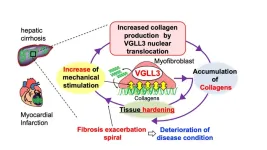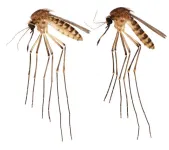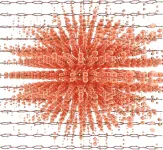(Press-News.org)
Fukuoka, Japan—Researchers from Kyushu University have found how a single mechanosensitive protein induces the process that thickens and scars tissue, known as fibrosis. The protein, called VGLL3, was shown to contribute to fibrosis in multiple organs.
The team hope their findings will lead to new treatments against fibrosis, a pathology that is attributed to 45% of all deaths in industrial nations. Their study was published in Nature Communications.
In response to any injury, the body immediately begins a stream of events. Blood coagulates, the tissue begins to inflame, and the body begins to heal. In some cases that healing comes in the form of scaring and hardening. When an injury is on your skin, it shows up as a visible scar, but what happens when vital organs like your heart or liver are damaged and hardens? If left unchecked, it can lead to loss of mechanics and dangerous consequences.
These changes in tissues are attributed to the extracellular matrix. The extracellular matrix is a web of proteins found in every cell in the body, and acts both like wires on a circuit that allow cells to communicate with each other, and the beams in a building, giving the organs its structure.
Too much extracellular matrix makes the cell, and by extension the organ, tough and inflexible, a condition known as fibrosis. In simple terms, fibrosis is a stiffening of cells and tissue. Its health implications are profound, as it can lead to poor pumping by the heart or cirrhosis in the liver.
"Myofibroblasts are a group of cells that produce collagen, a common extracellular matrix protein. In diseased organs they are seen overproducing collagen. Once myofibroblasts appear in diseased organs, fibrosis proceeds in a snowball fashion," says Michio Nakaya Associate Professor at Kyushu University's Faculty of Pharmaceutical Sciences who led the study. "At the same time, myofibroblasts are responsible for proper wound healing."
To understand how myofibroblasts turn pathological, Nakaya and his colleagues looked at how different physical stimuli changes the expression of genes in these cells. They found consistent changes in the expression of one gene: VGLL3.
Their study showed that after a heart attack, myofibroblasts in both mouse and human hearts express more VGLL3 protein which led to the production of collagen. VGLL3 was also expressed more in fibrotic mouse liver, suggesting it contributes to fibrosis in multiple organs. Conversely, preventing VGLL3 activation in mice led to far less fibrosis in these organs.
"We found that VGLL3 is translocated from the cytoplasm to the nucleus and begins to produce collage in response to mechanical stimuli. In mice without VGLL3, the fibrosis after a heart attack was reduced," noted Nakaya.
The study further showed that the relationship between matrix stiffness and VGLL3 activation becomes a pathological positive feedback loop, in that a stiffer matrix triggers more VGLL3 activation, which triggers the cell to produce more collagen.
Currently, there are only three drugs available for the treatment of fibrosis, and each has its limitations. Considering VGLL3's effects on cell stiffness, Nakaya believes research on treatments should give more attention to this protein.
"In the future, we expect to develop drugs and therapies for fibrosis by targeting VGLL3," concludes Nakaya.
###
For more information about this research, see "VGLL3 is a mechanosensitive protein that promotes cardiac fibrosis through liquid–liquid phase separation" Yuma Horii, Shoichi Matsuda, Chikashi Toyota, Takumi Morinaga, Takeo Nakaya, Soken Tsuchiya, Masaki Ohmuray, Takanori Hironaka, Ryo Yoshiki, Kotaro Kasai, Yuto Yamauchi, Noburo Takizawa, Akiomi Nagasaka, Akira Tanaka, Hidetaka Kosako, and Michio Nakaya in Nature Communications https://doi.org/10.1038/s41467-023-36189-6
About Kyushu University
Kyushu University is one of Japan's leading research-oriented institutes of higher education since its founding in 1911. Home to around 19,000 students and 8,000 faculty and staff, Kyushu U's world-class research centers cover a wide range of study areas and research fields, from the humanities and arts to engineering and medical sciences. Its multiple campuses—including one of the largest in Japan—are located around Fukuoka City, a coastal metropolis on the southwestern Japanese island of Kyushu that is frequently ranked among the world's most livable cities and historically known as Japan's gateway to Asia. Through its Vision 2030, Kyushu U will 'Drive Social Change with Integrative Knowledge.' Its synergistic application of knowledge will encompass all of academia and solve issues in society while innovating new systems for a better future.
END
CHICAGO – March 21, 2023 – A new study from VillageMD Research Institute, in collaboration with a scientist from Harvard-affiliated Marcus Institute for Aging Research, demonstrates the prevalence of frailty in both middle-aged and older adults and frail patients’ challenges in accessing healthcare in the United States. This study was recently published in the Journal of the American Medical Directors Association titled “Self-Reported Frailty and Health Care Utilization in Community-Dwelling Middle-Aged and Older Adults ...
Researchers from University of Pennsylvania, University or Maryland, and Emory University published a new Journal of Marketing article that examines how and why the language used in content engages readers.
The study, forthcoming in the Journal of Marketing, is titled “What Holds Attention? Linguistic Drivers of Engagement” and is authored by Jonah Berger, Wendy W. Moe, and David A. Schweidel.
Everyone wants to hold an audience’s attention. Brands want consumers ...
Another new mosquito species has made its way across the tropics into Florida, making a permanent home in at least three counties. Scientists are concerned because of the rate of new mosquitoes arriving in Florida and the potential for them to transmit mosquito-borne diseases.
A mosquito known only by its scientific name, Culex lactator, is the latest to establish in the Sunshine State, according to a new study published in the Journal of Medical Entomology by faculty at the UF/IFAS Florida Medical Entomology Laboratory (UF/IFAS FMEL).
This species was first discovered ...
A new leaf has turned in scientists' hunt for developing cutting-edge materials used in organic light-emitting diode (OLED) TV's, touchscreens, and more. The advance involves the polaron, a quasiparticle consisting of an electron and its surrounding distortions of atoms in a crystal lattice.
Simulations on the Texas Advanced Computing Center's (TACC) Frontera supercomputer have helped scientists map for the first time the conditions that characterize polarons in 2D materials, the thinnest materials that have ever been made.
"We charted a map to indicate in which materials polarons should be found, under what conditions, and the characteristics ...
Nearly a third of Americans (29%) say COVID-19 made them more worried than ever about having obesity prompting about 28 million people to consider weight-loss methods they hadn’t thought about before the pandemic began, including nearly 6.4 million thought about turning to either weight-loss surgery or taking prescription anti-obesity drugs for the first time, according to a new survey whose findings were published online in the peer-reviewed journal, Surgery for Obesity and Related Diseases (SOARD).
Another nearly 1 in 5 people (18%) said they were more likely to initiate a discussion about their weight with their physician specifically because ...
Following enormous collisions, such as asteroid impacts, some amount of material from an impacted world may be ejected into space. This material can travel vast distances and for extremely long periods of time. In theory this material could contain direct or indirect signs of life from the host world, such as fossils of microorganisms. And this material could be detectable by humans in the near future, or even now.
When you hear the words vacuum and dust in a sentence, you may groan at the thought of having ...
With the first paper compiling all known information about planets like Venus beyond our solar system, scientists are the closest they’ve ever been to finding an analog of Earth’s “twin.”
If they succeed in locating one, it could reveal valuable insights into Earth’s future, and our risk of developing a runaway greenhouse climate as Venus did.
Scientists who wrote the paper began with more than 300 known terrestrial planets orbiting other stars, called exoplanets. They whittled the list down to the five most likely to ...
New scientific research investigates inflammation and insulin resistance in habitual coffee drinkers to understand how coffee may reduce the risk of type 2 diabetes (T2D), mediated by inflammatory biomarkers in the body 1.
Drinking just one additional cup of coffee per day was associated with a 4-6% lower risk of T2D among participants in two large prospective cohort studies, which was partly explained by lower levels of inflammation1.
Experts consider consuming up to 400mg of caffeine (3-5 cups of coffee) per day to be a moderate and safe amount for most adults. For pregnant or lactating women, caffeine intake should be reduced to 200mg per day2.
These results further support previous ...
Working for a big company or in an HR role does not lower the likelihood of showing unconscious bias against disabled people at work, a new study finds.
Researchers say this is ‘surprising’ because of the money many large firms spend on EDI and unconscious bias training – in 2017 up to $8bn in the US alone – and the fact HR professionals are often specifically trained in EDI issues.
The research, a collaboration between the University of Exeter’s Business School and Medical ...
In a study of Danish children born between 1978–2000, chances of graduating from lower and upper secondary education were significantly lower for children born by cesarean section (CS). However, differences in grade point averages and intelligence scores were very small. The study, which is published in Acta Obstetricia et Gynecologica Scandinavica, also found that males born by CS had a lower likelihood of appearing before a conscription board for drafting into the military.
In Denmark, most students are 6–16 years old while in lower secondary education (LSE) and 16–17 years old when initiating ...




